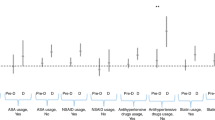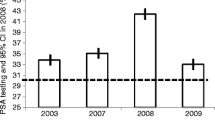Abstract
A lower risk of prostate cancer among diabetics has been suggested by several but not all studies. However, the studies have not always accounted for time since diagnosis of diabetes mellitus, or have not examined confounding factors such as diet and diagnostic bias. We thus examined this relationship in the Health Professionals Follow-Up Study from 1986 and 1994, in which 1,369 new cases of non-stage A1 prostate cancer were documented in 47,781 men. A prior history of a diagnosis of diabetes (mostly adult-onset) was associated with a reduced risk of prostate cancer (multivariate relative risk [RR] = 0.75; 95 percent confidence interval [CI] = 0.59-0.95) controlling for age, body mass index (wt/ht2) at age 21, and, in 1986, race, vasectomy, and intakes of total energy, total fat, calcium, fructose, and lycopene. After excluding the first year of follow-up after the diagnosis of diabetes, the RR was 0.63 (CI = 0.54-0.89). Prostate cancer was not reduced in the first five years after diagnosis (RR = 1.24, CI = 0.87-1.77), but was lower in the next five years (RR = 0.66, CI = 0.39-1.10) and lowest after 10 years (RR = 0.54, CI = 0.37-0.78); P-value for trend across time = 0.004. Similar associations were noted for advanced cases. Detection bias was unlikely to account for our findings. The basis of this relationship is unclear but may reflect hormonal changes related to diabetes, perhaps low testosterone levels.
Similar content being viewed by others
References
Henderson BE, Bogdanoff E, Gerkins VR, SooHoo J, Arthur M. Evaluation of cancer risk factors in a retirement community. Cancer Res1974; 34: 1045–8.
Thompson MM, Garland C, Barrett-Connor E, Khaw KT, Friedlander NJ, Wingard DL. Heart disease risk factors, diabetes, and prostatic cancer in an adult community. Am J Epidemiol1989; 129: 511–7.
La Vecchia C, Negri E, Franceschi S, D'Avanzo B, Boyle P. A case-control study of diabetes mellitus and cancer risk. Br J Cancer1994; 70: 950–3.
Adami HO, McLaughlin J, Ekbom A, et al.Cancer risk in patients with diabetes mellitus. Cancer Causes Control1991; 2: 307–14.
Kessler II. Cancer mortality among diabetics. JNatl Cancer Inst1970; 44: 673–86.
Ragozzino M, Melton JM III, Chu CP, Palumbo PJ. Subsequent cancer risk in the incidence cohort of Rochester, Minnesota, residents with diabetes mellitus. J Chronic Dis1982; 35: 13–9.
O'Mara BA, Byers T, Schoenfeld E. Diabetes mellitus and cancer risk: a multisite case-control study. J Chronic Dis1985; 38: 435–41.
Bach LA, Rechler MM. Insulin-like growth factors and diabetes. Diabetes Metab Rev1992; 8: 229–57.
Ando S, Rubens R, Rottiers R. Androgen plasma levels in male diabetics. J Endocrinol Invest1984; 7: 21–4.
Barrett-Connor E, Khaw KT, Yen SSC. Endogenous sex hormone levels in older adult men with diabetes mellitus. Am J Epidemiol1990; 132: 895–901.
Shahwan MM, Spathis GS, Fry DE, Wood PJ, Marks V. Differences in pituitary and testicular function between diabetic patients on insulin and oral anti-diabetic agents. Diabetologia1978; 15: 13–7.
Fushimi H, Horie H, Inoue T, et al.Low testosterone levels in diabetic men and animals: a possible role in testicular impotence. Diabetes Res Clin Pract1989; 6: 297–301.
Madsbad S, Gluud C, Bennett P, Krarup T. Rapid changes in plasma androgens during insulin withdrawal in male type 1 (insulin-dependent) diabetics. J Endocrinol Invest1986; 9: 21–5.
Small M, MacRury S, Beastall GH, MacCuish AC. Oestradiol levels in diabetic men with and without a previous myocardial infarction. Q J Med1987; 64: 617–23.
Barrett-Connor E. Lower endogenous androgen levels and dyslipidemia in men with non-insulin-dependent diabetes mellitus. Ann Intern Med1992; 117: 807–11.
Pienta KJ, Esper PS. Risk factors for prostate cancer. Ann Intern Med1993; 118: 793–803.
Giovannucci E, Rimm EB, Colditz GA, et al.Aprospective study of dietary fat and risk of prostate cancer. J Natl Cancer Inst1993; 85: 1571–9.
Rimm EB, Stampfer MJ, Colditz GA, Chute CG, Litin L, Willett WC. Validity of self-reported waist and hip circumferences in men and women. Epidemiology1990; 1: 466–73.
Rimm EB, Giovannucci EL, Stampfer MJ, Colditz GA, Litin LB, Willett WC. Reproducibility and validity of an expanded self-administered semiquantitative food frequency questionnaire among male health professionals. Am J Epidemiol1992; 135: 114–26.
Stampfer MJ, Willett WC, Speizer FE, et al.Test of the National Death Index. Am J Epidemiol1984; 119: 837–9.
National Diabetes Data Group: Classification and diagnosis of diabetes mellitus and other categories of glucose intolerance. Diabetes1979; 28: 1039–57.
Chan JM, Rimm EB, Colditz GA, Stampfer MJ, Willett WC. Obesity, fat distribution, and weight gain as risk factors for clinical diabetes in men. Diabetes Care1994; 17: 961–9.
Colditz GA, Willett WC, Stampfer MJ, et al.Weight as a risk factor for clinical diabetes in women. Am J Epidemiol1990; 132: 501–13.
Rothman KJ. Modern Epidemiology. Boston, MA (USA): Little, Brown, 1986.
Cupples LA, D'Agostino R, Anderson K, Kannel WB. Comparison of baseline and repeated measure covariate techniques in the Framingham Heart Study. Stat Med1988; 7: 205–18.
Giovannucci E, Ascherio A, Rimm EB, Stampfer MJ, Colditz GA, Willett WC. Intake of carotenoids and retinol in relation to risk of prostate cancer. J Natl Cancer Inst1995; 87: 1767–76.
Gleason DF, Mellinger GT, and the Veterans Administration Cooperative Urological Research Group. Prediction of prognosis for prostatic adenocarcinoma by combined histological grading and clinical staging. J Urology1974; 111: 58–64.
Giovannucci E, Rimm EB, Stampfer MJ, Colditz GA, Willett WC. Height, body weight, and risk of prostate cancer. Cancer Epidemiol Biomark Prev1997; 6: 557–63.
Coffey DS. Physiological control of prostatic growth: an overview. In: Prostate Cancer.Geneva, Switzerland: International Union Against Cancer, 1979; UICC Technical Report Series, Vol. 48: 4–23.
Hovenanian MS, Deming CL. The heterologous growth of cancer of the human prostate. Surg Gynecol Obstet1948; 86: 29–35.
Noble RL. The development of prostatic adenocarcinoma in Nb rats following prolonged sex hormone administration. Cancer Res1977; 37: 1929–33.
Pollard M, Luckert PH, Schmidt MA. Induction of prostate adenocarcinomas in Lobund Wistar rats by testosterone. Prostate1982; 4: 563–8.
Robson MC. Cirrhosis and prostatic neoplasms. Geriatrics1966; 21: 150–4.
Gann PH, Hennekens CH, Ma J, Longcope C, Stampfer MJ. A prospective study of sex hormone levels and risk of prostate cancer. J Natl Cancer Inst1996; 88: 1118–26.
Oksanen A. Testicular lesions of streptozotocin diabetic rats. Horm Res1975; 6: 138–44.
Hutson JC, Stocco DM, Campbell GT, Wagoner J. Sertoli cell function in diabetic, insulin-treated diabetic, and semistarved rats. Diabetes1983; 32: 112–6.
Jackson FL, Hutson JC. Altered responses to androgen in diabetic male rats. Diabetes1984; 33: 819–24.
Paz G, Homonnai ZT, Drasnin N, Sofer A, Kaplan R, Kraicer PF. Fertility of the strepozotocin-diabetic male rat. Andrologia1978; 10: 127–36.
Murray FT, Orth J, Gunsalus G, et al.The pituitary-testicular axis in the streptozotocin diabetic male rat: evidence for gonadotroph, Sertoli cell and Leydig cell dysfunction. Int J Androl1981; 4: 265–80.
Peehl DM, Stamey TA. Serum-free growth of adult human prostatic epithelial cells. In Vitro Cell Dev Bio1986; 22: 82–90.
Suikkari AM, Koivisto VA, Rutanen EM, Yki-Jarvinen H, Karonen SL, Seppala M. Insulin regulates the serum levels of low molecular weight insulin-like growth factor-binding protein. J Clin Endocrinol Metab1988; 66: 266–72.
LeRoith D, Baserga R, Helman L, Roberts CT Jr. Insulinlike growth factors and cancer. Ann Intern Med1995; 122: 54–9.
Cohen P, Peehl DM, Lamson G, Rosenfeld RG. Insulin-like growth factors (IGFs), IGF receptors, and IGF-binding proteins in primary cultures of prostate epithelial cells. J Clin Endocrinol Metab1991; 73: 401–7.
Cohen P, Peehl DM, Graves HCB, Rosenfeld RG. Biological effects of prostate specific antigen as an insulin-like growth factor binding protein-3 protease. J Endocrin1994; 142: 407–15.
Iwamura M, Sluss PM, Casamento JB, Cockett AT. Insulin-like growth factor I: action and receptor characterization in human prostate cancer cell lines. Prostate1993; 22: 243–52.
Horton R, Pasupuletti V, Antonipillai I. Androgen induction of steroid 5 alpha-reductasemay bemediated via insulin-like growth factor-I. Endocrinology1993; 133: 447–51.
Author information
Authors and Affiliations
Rights and permissions
About this article
Cite this article
Giovannucci, E., Rimm, E.B., Stampfer, M.J. et al. Diabetes mellitus and risk of prostate cancer (United States). Cancer Causes Control 9, 3–9 (1998). https://doi.org/10.1023/A:1008822917449
Issue Date:
DOI: https://doi.org/10.1023/A:1008822917449




